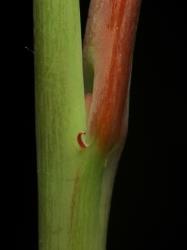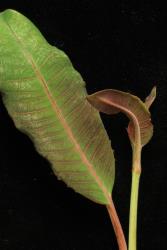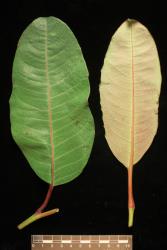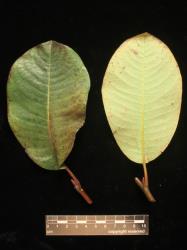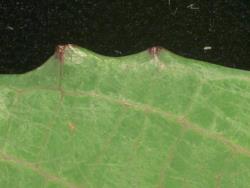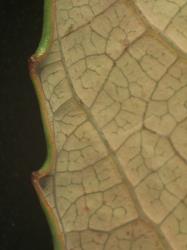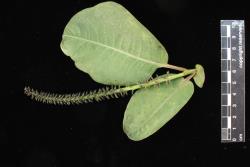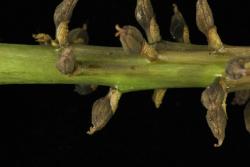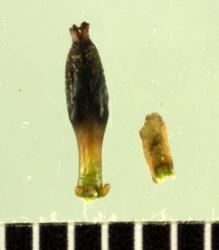Habit unknown. Current year's branchlets glabrous, 4.9–5.6 mm diameter. One-year-old branchlets glabrous. Leaf buds red-brown (UCL43), 7.5 mm long, 6 mm wide, glabrous. Leaves alternate. Stipule cylindrical, 1 mm long, not persisting. Petiole 20–42 mm long, glabrous, glands absent, base of petiole with a slight pulvinus. Leaf lamina 82–175 mm long, 54–85 mm wide, length to width ratio 1.4–2.4:1, obovate or elliptical; base rounded; apex rounded to acuminate; leaf galls absent; margins distantly toothed, finely revolute; upper lamina surface smooth, dull, glabrous, stomata absent; lower surface with midvein and side-veins raised, netted veins visible, indistinctly glaucous, glabrous. Catkins female or male, emergence coetaneous with leaves. Flowering branch 120–150 mm long, 5 leaves on flowering branch. Male catkin 35 mm long, 5 mm wide. Female catkin 90–130 mm long, 11 mm diameter; catkin rachis visible between flowers, glabrous. Flower bracts 2.0 mm long, 0.8 wide, uniformly brown, flat, obovate; apex rounded, glabrous; female bract persistent. Male nectaries 2, with 2 small lateral nectaries, inner nectary 0.3 mm long, 0.1 mm in diameter, cylindrical. Stamens 2, filaments united at their base, hairs absent; anthers 0.7 mm long. Female nectary 1, 0.8 mm long, 1.0 mm wide, 2-lobed; ovary 1.8 mm long, glabrous, with stomata, longer than the flower bract; stipe 1.6 mm long; style 0.2 mm long, style arms 0.5 mm long.
The plant is completely glabrous. Leaves are large, elliptical to obovate, with entire or crenate margins that are finely recurved. Catkin rachis and stamen filaments are glabrous. The female catkin is exceptionally long, 90–130 mm. A very distinctive species that may not be recognised as a willow unless in flower and not resembling any other willow present in New Zealand.
In cultivation in Gisborne (Eastwood Hill, Sykes, 1966, Hackfalls Arboretum 2017), Southern North Island (Plant and Food Research's Massey Orchard PN264). Probably in other public and private gardens in New Zealand.
First collection: CHR 130283, W. R. Sykes, 13 November 1962, Christchurch Botanic Garden.
First publication: This publication.
Flowering: Mid-October.
Unknown, but flow cytometry provisionally indicates that PN264 is triploid.



